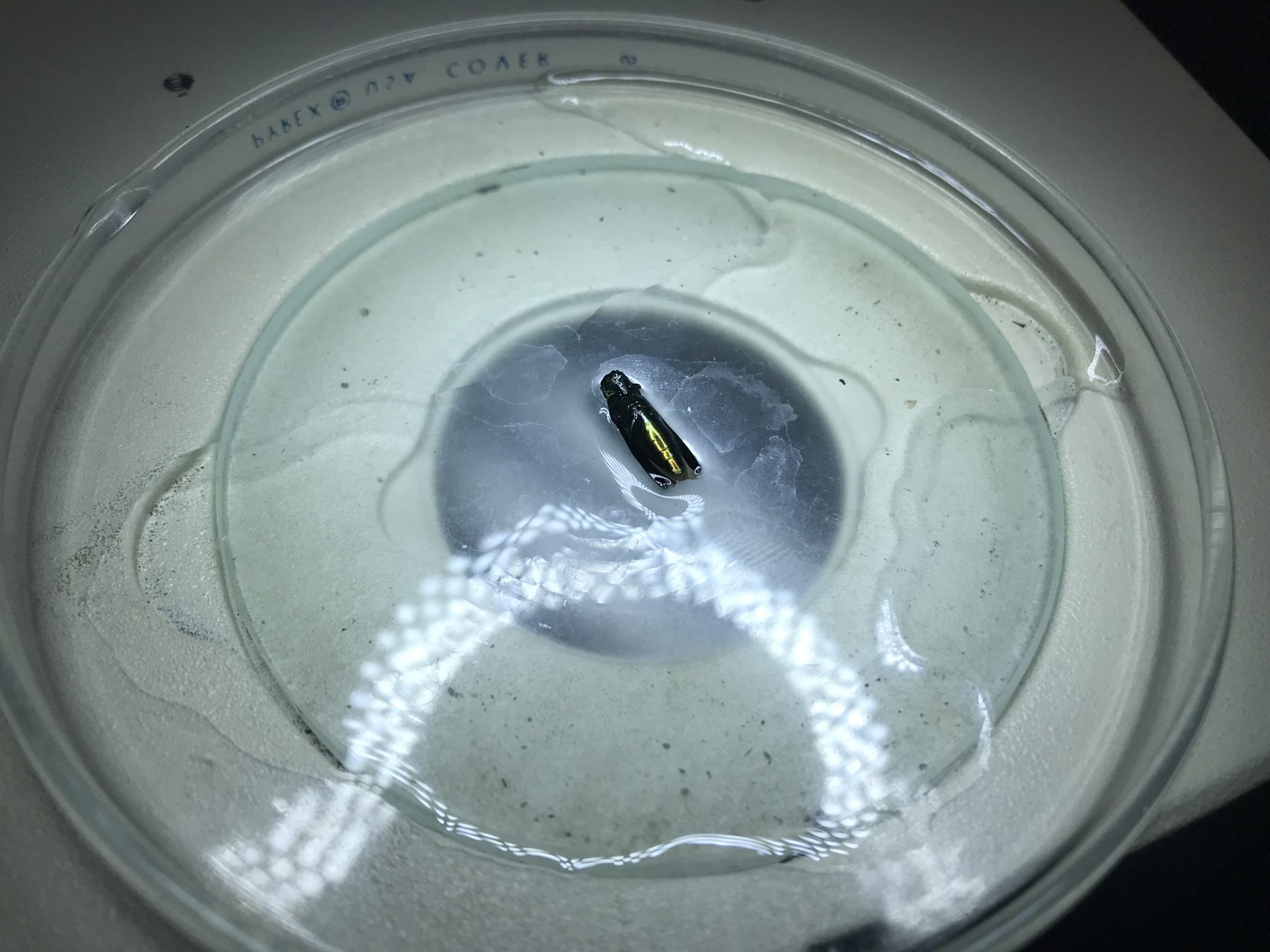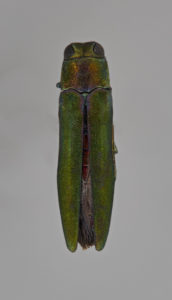
National and state experts have confirmed the presence of emerald ash borer (EAB) – an invasive, highly destructive tree pest – in the city and county of Broomfield, northwest of Denver. This detection represents the first confirmation of EAB in Colorado outside of a federal quarantine, which primarily encompasses Boulder County, established in 2013 in an effort to prevent or slow the insect’s spread.
An estimated 15 percent or more of all urban and community trees in Colorado are ash species susceptible to being killed by EAB – and a majority of these trees are on private land. EAB attacks and kills both stressed and healthy ash trees and is so aggressive that trees typically die within two to four years after becoming infested.
EAB was first confirmed in Colorado in September 2013, in the city of Boulder. Since then, the pest has been confirmed in Gunbarrel, Longmont, Lafayette, Lyons and Superior – all within the quarantine area.
Broomfield’s EAB detection occurred near 136th Avenue and Main Street, but it is unknown whether the pest arrived by natural spread or via accidental human transport, such as in firewood or other raw ash material. Populations of the insect are capable of spreading a half-mile each year on their own, and Broomfield is near other EAB detections.
Due to Broomfield’s proactive public education campaign, a Broomfield resident familiar with the appearance of EAB recently noticed a suspicious insect on their property and contacted the city forester, who collected the specimen. He delivered the insect to the Colorado Department of Agriculture and Colorado State University experts, who first confirmed it as being EAB; it was then confirmed a second time by a national EAB expert in Brighton, Mich., per federal protocols.

Although the detection occurred outside the existing quarantine, which is intended to prevent the human-assisted spread of EAB via ash nursery stock, firewood and other wood that may contain the pest, the quarantine boundaries will not change at this time. This is because no symptomatic trees were observed in connection with the specimen – a requirement for quarantine changes from the USDA Animal and Plant Health Inspection Service, which oversees federal EAB quarantines nationally.
Before this latest detection occurred, the Colorado Department of Agriculture and APHIS had been preparing to repeal the EAB quarantine this winter, with a formal process to begin later this month. This action is based on several factors:
- EAB adults move to new areas naturally, and their spread is imminent, as they do not rely on humans moving infested wood as a sole means for population expansion.
- Ending the quarantine will allow already-affected communities more options for utilizing and disposing of removed trees.
- Other means are now in place to help slow the spread of EAB in Colorado, including: thousands of ash trees are now chemically treated in affected communities, which will help blunt insect population growth; biocontrols that prey on EAB were released and are now established in Boulder, which likewise should help check future EAB population growth; and long-term, interagency outreach efforts are ongoing, enabling more rapid new detections.
“The primary purpose of this quarantine has been to slow the spread of EAB in Colorado, and we believe this is one reason it’s taken so long for the pest to be confirmed outside Boulder County,” said Laura Pottorff, a CDA plant health and certification section chief and lead member of the Colorado EAB Response Team. “Based on recent data from the eastern U.S., our expectation is that EAB cannot be prevented from leaving the quarantine. We’re just glad we’ve given Front Range communities more time to better plan and prepare for its arrival.”
Many Front Range communities have been managing for EAB before its arrival, including Broomfield. In 2016, Broomfield began implementing an EAB management plan that includes tools such as EAB monitoring and detection; public outreach; and ash tree removals, treatments and replacements. The plan also takes into account wood utilization/disposal and budget implications.
Broomfield had approximately 2,900 public ash trees susceptible to EAB when it first developed its management plan three years ago, which comprised about 10 percent of the total public tree population. Since implementing its management plan, however, the city has reduced the ash population to just 1,500 trees. It also has treated 931 ash trees identified as being of high value, and planted nearly 900 replacement trees. Broomfield’s forestry department will continue to individually protect and remove/replace ash trees based on how each tree is designated in its management plan.
EAB tips for Front Range Residents:
- Determine now if you have any ash trees. Identifying features of ash trees include compound leaves with 5 to 9 leaflets; leaflets, buds and branches growing directly opposite from one another; and diamond-shaped bark ridges on mature trees. More information about a related app for mobile devices is available at csfs.colostate.edu/emerald-ash-borer.
- If you have an ash tree, start planning. Decide if the overall health of the tree merits current or future treatment or if it would be best to remove and replace it with a different species. If you aren’t sure, contact a certified arborist. If pesticide treatment is the preferred option, the applicator must be licensed by the Colorado Department of Agriculture as a Commercial Pesticide Applicator.
- Recognize signs of EAB infestation. Property owners with ash trees should be on the lookout for thinning of leaves in the upper tree canopy, 1/8-inch D-shaped holes on the bark and vertical bark splitting with winding S-shaped tunnels underneath. Report suspect trees by calling the Colorado Department of Agriculture at 1-888-248-5535 or filling out the EAB Report Form at https://www.colorado.gov/pacific/agplants/eab-identification-and-reporting.
- Be aware of EAB imposters. Other insects like lilac/ash borer, ash bark beetle and flat-headed apple tree borer may look like EAB or cause similar tree symptoms. For more information, visit www.eabcolorado.com.
-
Help prevent further spread of EAB. Do not transport ash or any hardwood firewood, or any other untreated ash wood products, to other locations. Boulder County and some surrounding areas are still under a federal EAB quarantine, allowing for significant fines for those who move untreated wood from the area.
For more information about ash tree identification, the symptoms of EAB and treatment options, go to eabcolorado.com or csfs.colostate.edu/emerald-ash-borer.
About Emerald Ash Borer, state response team
Emerald ash borer (EAB) is a non-native, wood-boring beetle that is responsible for the death or decline of tens of millions of ash trees in the United States and Canada. This insect was first discovered in Michigan in 2002, and since then it has spread to at least 35 states, including Colorado. As a non-native insect, EAB lacks predators in North America to keep it in check. EAB typically only attacks ash trees in the genus Fraxinus, but has also been documented infesting white fringe tree. Mountain ash and other tree species are not susceptible.
The Colorado EAB Response Team includes members from the following agencies/organizations: Colorado Department of Agriculture, Colorado State Forest Service, City of Boulder, Boulder County, Colorado State University Extension, Colorado Tree Coalition, Green Industries of Colorado, University of Colorado, USDA Animal and Plant Health Inspection Service and various Front Range municipalities.